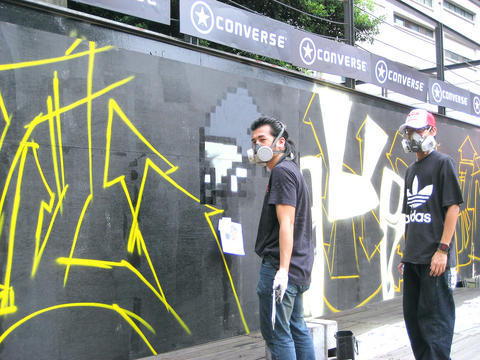For graffiti artists Ano and Bounce, there are two major challenges involved in producing graffiti in Taipei: finding the right location and avoiding detection long enough to finish the job.
A highly visible spot, such as a wall next to an MRT station, is a perfect location for street art. But in such a busy place, it is hard to spend several hours working on a piece without attracting the attention of the police.
"We like to express ourselves and communicate through graffiti, but the city punishes us for presenting our works in an unconventional location and manner," Ano, who has been a graffiti artist for six years and whose works can be found on many street corners in Taipei, told the Taipei Times.

PHOTO COURTESY OF TAIPEI CITY'S CULTURAL AFFAIRS DEPARTMENT
As a relatively young art form in Taiwan, graffiti is often dismissed as vandalism. Although the Taipei City Government softened its stance somewhat in 2005, when it made three of the retaining walls at Dachia Ying Feng Riverside available to graffiti artists, most artists still work in out-of-the-way places to avoid the police.
Things took a turn for the worse last year, when the city's Department of Environmental Protection established an around-the-clock hotline and cash rewards for those who report graffiti.
Graffiti artists face fines of between NT$1,200 and NT$6,000 for violating Article 27 of the Waste Disposal Act (
This lack of freedom frustrates Bounce and Ano, who declined to give their real names.
"We are not bad kids and we take graffiti as an art form very seriously. We don't write four-letter words or paint horrible images," Bounce said.
The duo try to avoid stereotypical "dirty," gloomy or creepy grafitti in favor of "cute" pieces with bright, warm colors and positive messages.
Bounce centers his pieces around a blind rabbit that loves music -- the character from which he takes his nickname.
Ano, meanwhile, creates graffiti mosaics.
"We do graffiti to make the city more beautiful and lively," Bounce said.
In a rare gesture of reconciliation, the city's Department of Cultural Affairs announced on Saturday that the fences around major public construction sites would be made available to graffiti artists.
"We will promote graffiti starting with the public sector, and then later in the private sector too. It's our goal to beautify the city with graffiti," department head Lee Yong-ping (
The department said it was also cooperating with the city's Water Conservancy Agency to open more of the walls at municipal riverside parks to graffiti artists, while working with the Taiwan Youth Rights and Welfare Advocacy Alliance to hold graffiti contests and festivals to promote the street art.
Bounce and Ano welcomed the news, but urged the city government to provide more locations closer to downtown and with convenient transportation.
"The spaces at riverside parks are so remote that I don't even know where those walls are," Ano said.
"People think graffiti artists like to paint on dark and abandoned walls or buildings, but the truth is we are afraid of those places. We'd love to do our art in a bright and safe environment," he said.
Having spent years sneaking around the city in search of the perfect canvas, Bounce and Ano hope that they will soon be able to share their creativity more openly.

An essay competition jointly organized by a local writing society and a publisher affiliated with the Chinese Communist Party (CCP) might have contravened the Act Governing Relations Between the People of the Taiwan Area and the Mainland Area (臺灣地區與大陸地區人民關係條例), the Mainland Affairs Council (MAC) said on Thursday. “In this case, the partner organization is clearly an agency under the CCP’s Fujian Provincial Committee,” MAC Deputy Minister and spokesperson Liang Wen-chieh (梁文傑) said at a news briefing in Taipei. “It also involves bringing Taiwanese students to China with all-expenses-paid arrangements to attend award ceremonies and camps,” Liang said. Those two “characteristics” are typically sufficient

A magnitude 5.9 earthquake that struck about 33km off the coast of Hualien City was the "main shock" in a series of quakes in the area, with aftershocks expected over the next three days, the Central Weather Administration (CWA) said yesterday. Prior to the magnitude 5.9 quake shaking most of Taiwan at 6:53pm yesterday, six other earthquakes stronger than a magnitude of 4, starting with a magnitude 5.5 quake at 6:09pm, occurred in the area. CWA Seismological Center Director Wu Chien-fu (吳健富) confirmed that the quakes were all part of the same series and that the magnitude 5.5 temblor was

The brilliant blue waters, thick foliage and bucolic atmosphere on this seemingly idyllic archipelago deep in the Pacific Ocean belie the key role it now plays in a titanic geopolitical struggle. Palau is again on the front line as China, and the US and its allies prepare their forces in an intensifying contest for control over the Asia-Pacific region. The democratic nation of just 17,000 people hosts US-controlled airstrips and soon-to-be-completed radar installations that the US military describes as “critical” to monitoring vast swathes of water and airspace. It is also a key piece of the second island chain, a string of

The Central Weather Administration has issued a heat alert for southeastern Taiwan, warning of temperatures as high as 36°C today, while alerting some coastal areas of strong winds later in the day. Kaohsiung’s Neimen District (內門) and Pingtung County’s Neipu Township (內埔) are under an orange heat alert, which warns of temperatures as high as 36°C for three consecutive days, the CWA said, citing southwest winds. The heat would also extend to Tainan’s Nansi (楠西) and Yujing (玉井) districts, as well as Pingtung’s Gaoshu (高樹), Yanpu (鹽埔) and Majia (瑪家) townships, it said, forecasting highs of up to 36°C in those areas